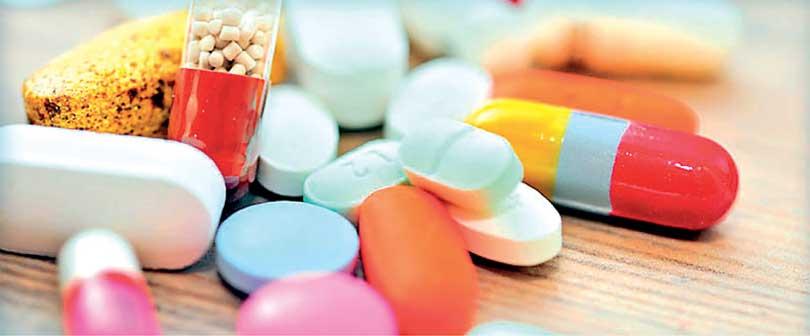Reply To:
Name - Reply Comment
Last Updated : 2024-05-19 23:42:00
 The 300% increase in the cost of medicines is unbearable for the public
The 300% increase in the cost of medicines is unbearable for the public
 The prevailing medicine shortage in the country has existed over the past few months and medical experts blame stakeholders in the medical sector for not taking the responsibility to rectify the matter. Patients have been severely inconvenienced as they cannot find drugs prescribed by doctors apart from the fact that they have to join long queues to seek treatment. Some of the suggestions include cutting down on the import of non-essential drugs and opt for less high-end brands, with assurances that the quality will not be compromised on.
The prevailing medicine shortage in the country has existed over the past few months and medical experts blame stakeholders in the medical sector for not taking the responsibility to rectify the matter. Patients have been severely inconvenienced as they cannot find drugs prescribed by doctors apart from the fact that they have to join long queues to seek treatment. Some of the suggestions include cutting down on the import of non-essential drugs and opt for less high-end brands, with assurances that the quality will not be compromised on.
Overcrowding in Govt. hospitals
“We initially identified an essential drug shortage at the Ministry, but right now we are managing with alternatives,” opined Ampara Regional Director of Health Services, Dr. Prasanga Serasinghe. “There were ways of obtaining medicines from outside, but we have observed shortages in supplies around the country. We also observe more patients in orthopedic clinics and since charges in private clinics have increased, more patients now opt for treatment at government hospitals. Therefore there’s more crowding at government hospitals and there’s a spike in the demand for medicines. We have to accept the fact that there’s a problem with supplies. If medicines aren’t available with the main distributor/supplier then we would have to wait. However the Medical Supplies Division receives a weekly feedback and they inform us when there’s a critical situation. Now we get a daily update because there are certain fast-moving drugs which are needed daily. Our team visits peripheral hospitals to analyse the situation prior to dispensing drugs to patients. We are maintaining buffer stocks at the moment,” said Dr. Serasinghe.
GMOA reveals further reasons for drug shortage
“We have been discussing about this issue with responsible parties for over six months,” opined Government Medical Officers’ Association Spokesperson Dr. Chamil Wijesinghe. “There were instances when we couldn’t manage and there was a shortage among all types of drugs from antibiotics to painkillers, drugs for diabetes patients, hypertension, consumables, laboratory items, reagents, X-ray items and so forth. The shortage has in fact affected the entire health system from the National Hospital to all rural hospitals,” said Dr. Wijesinghe.
A special committee setup by the GMOA to investigate the shortage of supplies has identified several other issues in addition to the forex crisis and the lack of funding and transport when distributing medicines. “There are several stakeholders in the health sector including the State Pharmaceuticals Corporation, State Pharmaceuticals Manufacturing Corporation, National Medicines Regulatory Authority, MDS etc, and we see that there’s inefficiency and a lack of coordination among them and that this is the main reason behind the prevailing medicines shortage. It takes a long time to procure a drug or consumable and there are underhand deals and bribery that fuels the drug mafia. Therefore it is important to increase the efficiency of the procuring procedures and eliminate the drug mafia. Local purchasing of drugs provides a huge chance for wrongdoings and therefore it has to be monitored strictly. Price control too needs to be imposed on medicines. The GMOA is ready to assist stakeholders when taking these measures,” said Dr. Wijesinghe.
As immediate measures the GMOA suggests that the government should look for donations and sort out the maldistribution of medicines among hospitals. “There are enough stocks of one medicine in one hospital and zero stocks in another. The Ministry should update stocks frequently so that there won’t be shortages in future,” opined Dr. Wijesinghe.
What happened to the USD 200 million Indian Credit Line?
“There’s a shortage of around 90 essential drugs, but if there’s even one tablet the Ministry says there’s no shortage,” said Association of Medical Laboratory Scientists and Professionals President Ravi Kumudesh. “The drug supply chain has been impacted due to delays in procurement and the forex crisis. If there are no medicines in the supply chain we are in for a bigger problem. There are either limited or no stocks at the hospital level. When stocks runout at hospital pharmacies the MSD restocks the products and it goes as a cycle. However the stocks distributed from MSD to hospitals are running out and there’s an issue in distribution among MSD and SPC. But when we analysed it has been brought to our notice that the USD 200 million obtained from the Indian Credit Line has not been used and in that case there cannot be a drug shortage in the country. However the process to procure a drug sent by the Indian Credit Line is quite complex. There has to be a focal point to monitor these delays.”
Wastage on importing non-essential drugs, high-end brands
Even though the previous budget allocated Rs. 61 billion for the health sector, the Treasury has not released these funds at once. Medical experts opine that on the other hand, this amount is not sufficient and is another contributing factor to the prevailing drug shortage. “Anesthetics such as dibucaine which are quite cost-effective are not available in hospitals,” cautioned All Ceylon Medical Officers Association Secretary Dr. Jayantha Bandara. “This is used as an anesthetic in 40-50% of surgeries and would cost around INR 22-30. But there’s no proper plan to procure such cost-effective drugs. Drugs for patients diagnosed with meningitis are unavailable and are quite costly,” said Dr. Bandara.
The 300% increase in the cost of medicines is unbearable for the public. The shortage would also lead to complications in people who have non-communicable diseases for instance. “Another issue is that Sri Lanka imports quite a number of non-essential drugs such as vitamins, minerals and borderline products such as supplements which are sitting idle on shelves,” Dr. Bandara further said. “The country wastes a lot of dollars on non-essential drugs to cater to the needs and wants of private pharma companies. On the other hand Sri Lanka should consider cutting down expenses on high end brands because I can guarantee that the quality is never compromised. A quality assurance is conducted on every drug that is imported to the country and the public need not have any fear in this regard. This way, the expenses on the purchase of drugs could be reduced by 75%,” said Dr. Bandara.

Although there’s funding available the usage of funding comes with so many restrictions. But the 14 essential lifesaving drugs are available. There was a shortage of anti-rabies medicines and I managed to get them as well
- Keheliya Rambukwella Health Minister
Availability of drugs, consumables and equipment is a must in my agenda : Rambukwella
When contacted, Health Minister Keheliya Rambukwella said that he’s constantly monitoring the situation and that there are so many restrictions in the transactions. “The Asian Development Bank takes from 6-9 months to complete the procurement process and I have spoken to them about reducing the procurement period to around 4-5 months. Although there’s funding available the usage of funding comes with so many restrictions. But the 14 essential lifesaving drugs are available. There was a shortage of anti-rabies medicines and I managed to get them as well,” said Minister Rambukwella.

The drug supply chain has been impacted due to delays in procurement and the forex crisis. If there are no medicines in the supply chain we are in for a bigger problem. There are either limited or no stocks at the hospital level
- Ravi Kumudesh President Association of Medical Laboratory Scientists and Professionals
Responding to claims about not utilising the Indian Credit Line, Minister Rambukwella said that these claims are partly true. “We have used only US$ 35 million from the US$ 125 million we received; I’m giving US$ 25 million to the government sector and US$ 55 million to the private sector because procurement in the private sector is much faster than in the government sector. There are 18 approvals to be sorted in the government sector. When it comes to drugs, equipments, consumables etc., the priority is availability and it is a must in my agenda; second is pricing. I had a chat about pricing with the usual suppliers and I have instructed them to not expect their usual profits,” the Minister said.
 The country wastes a lot of dollars on non-essential drugs to cater to the needs and wants of private pharma companies. On the other hand Sri Lanka should consider cutting down expenses on high end brands because I can guarantee that the quality is never compromised
The country wastes a lot of dollars on non-essential drugs to cater to the needs and wants of private pharma companies. On the other hand Sri Lanka should consider cutting down expenses on high end brands because I can guarantee that the quality is never compromised
-Dr. Jayantha Bandara Secretary All Ceylon Medical Officers Association Secretary

Add comment
Comments will be edited (grammar, spelling and slang) and authorized at the discretion of Daily Mirror online. The website also has the right not to publish selected comments.
Reply To:
Name - Reply Comment
The state-run loss-making State Mortgage & Investment Bank (SMIB) has reveale
US authorities are currently reviewing the manifest of every cargo aboard MV
On March 26, a couple arriving from Thailand was arrested with 88 live animal
According to villagers from Naula-Moragolla out of 105 families 80 can afford
17 May 2024 - 0 - 130